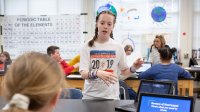Making Learning Targets Clear to Students
When students clearly understand classroom expectations, they’re better able to assess and improve their performance.
Your content has been saved!
Go to My Saved Content.The third-grade classroom is busy. Students are in the middle of making slime, and you can sense the level of engagement across the class. The teacher is working very hard to make sure that students are clear on the goals of learning: to understand the relationships between solids, liquids, and gases. The students can see success criteria posted on the wall and examples of successful work spread across the room. Visiting teachers are engaging in random checks of understanding to ensure that students are clear on expectations.
As part of the school’s improvement process, teachers and principals are visiting classrooms and interviewing students on their understanding of the expectations of learning, the students’ self assessment on their progress, and what next steps they need to take to meet established goals. The team was in the third-grade classroom and filmed student interviews; they discussed the key findings with the teacher after class.
Here are samples of two interviews of students in the same classroom.
Interview 1
Teacher: What are you learning?
Student: We’re learning about slime.
Teacher: How do you know if you are successful?
Student: We don’t want the slime to stick to us.
Interview 2
Teacher: What are you learning?
Student: We’re learning about solids, liquids, and gases.
Teacher: How do you know if you are successful?
Student: We can define and relate each phase. Right now we’re learning about solids, liquids, and gases by creating slime.
The teacher is doing great things. The question is whether all students are following the teacher’s lead. Building student clarity is a constant pursuit: We never arrive, but it’s worth our focus.
Clarity Research Snapshot
When students are clear on expectations of learning, they tend to double their rate of learning. Moreover, when students are clear on expectations, they have a better chance of assessing their current performance and using feedback accurately. As John Hattie explains in Visible Learning, self assessment, feedback, and student clarity yield substantial growth in student learning. Yet the implementation of this idea is extremely difficult.
Let’s take a look at some challenges and solutions to implementation.
Challenge 1. Novices don’t really understand rubrics: Experts love rubrics because the bullet points clearly delineate the core expectations that they want students to learn. Novices don’t fully appreciate the bullet points because they simply don’t have a concrete example of what’s written. As such, they scan the tool for items that are familiar to them: activities (such as getting into groups), tasks (such as completing six problems correctly), and contexts (such as exploring bridges). Because of this scanning for the familiar, students begin thinking about group work, assignment completion, and bridges and are therefore less likely to be any clearer on the standards they’re learning about.
To focus students on the actual learning, teachers are encouraged to start with examples of great work that meets the expectations of the teacher. The more students see examples of great work in multiple contexts, the better able students are to use rubrics to evaluate their own work as well as to give, receive, and use feedback. This also makes it easier for them to focus on the core content that the teacher is after.
Challenge 2. Telling people the expectations clearly doesn’t mean the expectations are clear to them: As a school leader, I have found that simply sending a clear message to people doesn’t ensure that they are clear on my message. Almost every message I send must be followed up with clarifying emails, meetings with parents and/or faculty, and a series of communication check-ins. As such, developing clarity isn’t one way. Clarity is interactive and built through multiple engagements.
Co-construction is an interactive process that enables students to build clarity of expectations. Co-construction is the active involvement of building success criteria with students rather than presenting success criteria to students. Here is one example of co-construction:
- Providing students with work samples that illustrate success
- Asking students to identify the parts of the work sample that make it successful (i.e., criteria for success)
- Writing out the criteria for success with students
Challenge 3. The classroom is mostly hidden from teachers, and students give each other inaccurate feedback: As Graham Nuthall tells us in The Hidden Lives of Learners, the majority of the classroom experience is hidden from the teacher’s observation. In the hidden classroom, kids typically give and receive most of the feedback to and from their peers, and most of that feedback is incorrect. To address this, we should consider having students do the following:
- Use the fishbowl protocol to share their feedback, and process the accuracy of the feedback to the expectations of the lesson or unit
- Begin units with discussions on what mastery looks like, and have students evaluate the differences between various levels of mastery
Students’ achievement and attitude improve when they have the tools to own their own learning. As educators, it’s up to us to provide those tools.
